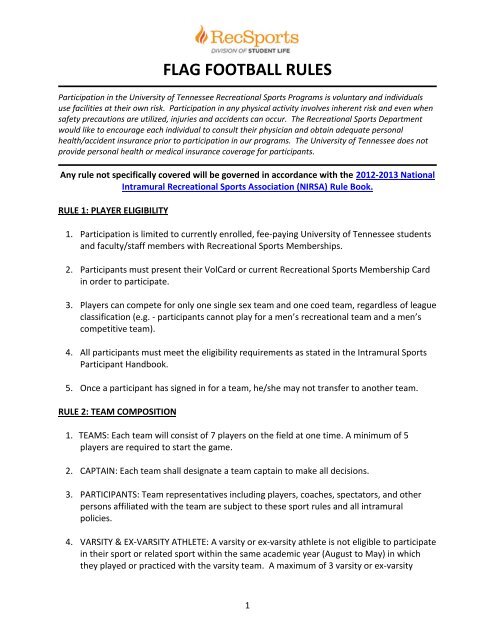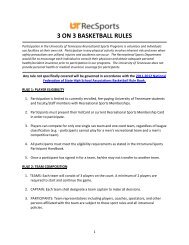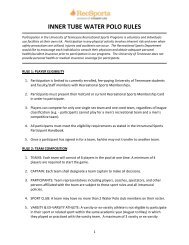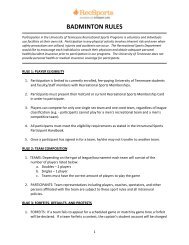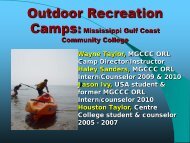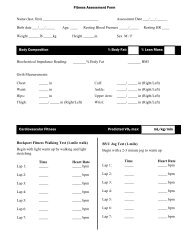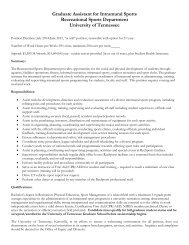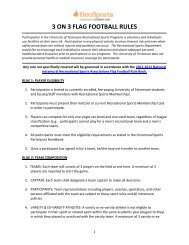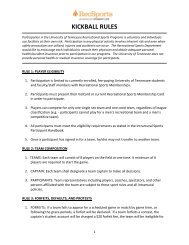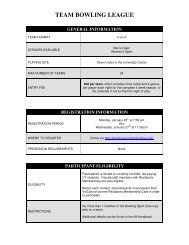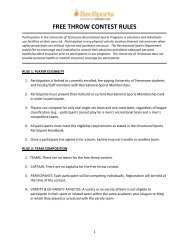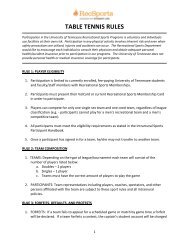FLAG FOOTBALL RULES - RecSports
FLAG FOOTBALL RULES - RecSports
FLAG FOOTBALL RULES - RecSports
Create successful ePaper yourself
Turn your PDF publications into a flip-book with our unique Google optimized e-Paper software.
<strong>FLAG</strong> <strong>FOOTBALL</strong> <strong>RULES</strong><br />
Participation in the University of Tennessee Recreational Sports Programs is voluntary and individuals<br />
use facilities at their own risk. Participation in any physical activity involves inherent risk and even when<br />
safety precautions are utilized, injuries and accidents can occur. The Recreational Sports Department<br />
would like to encourage each individual to consult their physician and obtain adequate personal<br />
health/accident insurance prior to participation in our programs. The University of Tennessee does not<br />
provide personal health or medical insurance coverage for participants.<br />
Any rule not specifically covered will be governed in accordance with the 2012-2013 National<br />
Intramural Recreational Sports Association (NIRSA) Rule Book.<br />
RULE 1: PLAYER ELIGIBILITY<br />
1. Participation is limited to currently enrolled, fee-paying University of Tennessee students<br />
and faculty/staff members with Recreational Sports Memberships.<br />
2. Participants must present their VolCard or current Recreational Sports Membership Card<br />
in order to participate.<br />
3. Players can compete for only one single sex team and one coed team, regardless of league<br />
classification (e.g. - participants cannot play for a men’s recreational team and a men’s<br />
competitive team).<br />
4. All participants must meet the eligibility requirements as stated in the Intramural Sports<br />
Participant Handbook.<br />
5. Once a participant has signed in for a team, he/she may not transfer to another team.<br />
RULE 2: TEAM COMPOSITION<br />
1. TEAMS: Each team will consist of 7 players on the field at one time. A minimum of 5<br />
players are required to start the game.<br />
2. CAPTAIN: Each team shall designate a team captain to make all decisions.<br />
3. PARTICIPANTS: Team representatives including players, coaches, spectators, and other<br />
persons affiliated with the team are subject to these sport rules and all intramural<br />
policies.<br />
4. VARSITY & EX-VARSITY ATHLETE: A varsity or ex-varsity athlete is not eligible to participate<br />
in their sport or related sport within the same academic year (August to May) in which<br />
they played or practiced with the varsity team. A maximum of 3 varsity or ex-varsity<br />
1
athletes may compete for 1 team in a non-related sport. See the Intramural Sports<br />
Participant Handbook for specifications.<br />
RULE 3: FORFEITS, DEFAULTS, AND PROTESTS<br />
1. FORFEITS: If a team fails to appear for a scheduled game or match by game time, or<br />
following the grace periods, a forfeit will be declared. If a team forfeits a contest, the<br />
captain’s student account will be charged a $20 forfeit fee, the team will be ineligible for<br />
postseason competition, and the team may be dropped from the league if there is a wait<br />
list team to replace them. A team with two forfeits will be automatically dropped from<br />
the league.<br />
2. DEFAULTS: If a team notifies the intramural office of their inability to field the required<br />
number of participants for their game, no later than 2:00PM on the day of the contest, it<br />
will be marked as a default. If a team has one less than the minimum number of<br />
participants required to play signed in at game time or during the grace period, an on-site<br />
default will be declared. A default/on-site default is an un-played game that is recorded as<br />
a loss with a sportsmanship rating of a 3 for the defaulting team. Once the default has<br />
been requested, it cannot be overturned. No forfeit fine is charged to the defaulting team.<br />
3. GRACE PERIOD: Teams will be granted a 5 minute grace period from the original game<br />
time if at least one player has signed in at game time. If the minimum number of players<br />
required to start have signed in before the grace period has concluded, the game will<br />
begin and the opposing team will be awarded 7 points. The game clock for the first half<br />
will be set at 13 minutes. If no players are signed in at game time, there is no grace<br />
period and the game will be declared a forfeit.<br />
4. OPTIONAL GRACE PERIOD: After the original grace period has expired, the opposing<br />
captain has the option of taking the win or waiting an additional 5 minutes. In the event<br />
the captain decides to wait, the decision is irreversible. If the minimum number of players<br />
required to start are signed in before the optional grace period has expired, the game will<br />
begin and the opposing team will be awarded an additional 7 points (total of 14 points).<br />
The game clock for the first half will be set at 8 minutes.<br />
5. PROTESTS: If a team wants to submit a protest, the team captain must stop play<br />
immediately and notify the games officials and intramural sports manager. The<br />
intramural sports manager will document the appeal and forward it to the intramural<br />
sports Graduate Assistants or Coordinator if they cannot settle the protest on site. Teams<br />
cannot protest an official’s judgment.<br />
2
RULE 4: PLAYING AREA AND EQUIPMENT<br />
1. PLAYING AREA: Games will be played at the Recreational Sports turf Fields located next to<br />
the Tennessee Recreational Center for Students (TRECS).<br />
Scoreboard #1 Scoreboard #2 Scoreboard #3<br />
1. <strong>FOOTBALL</strong>: Teams may furnish their own game ball or check-out a game ball. The game<br />
ball must be pebble-grained leather or rubber-covered and meet the recommendations of<br />
size and shape for a regulation football. There are no requirements regarding ball<br />
pressure or markings. Men shall use the regular size ball only. The regular, intermediate,<br />
youth, or junior size football shall be used for women’s games. The officials shall be the<br />
sole judge of any ball offered for play and may change the ball during play at their<br />
discretion.<br />
2. <strong>FLAG</strong> BELTS: Each player must wear a one piece quick release belt, without any knots, at<br />
the waistline with three flags permanently attached, one flag on each side and one in the<br />
center of the back. Flag belts will be provided to each team on site.<br />
3. JERSEYS/SHIRTS: Teams are encouraged to furnish their own matching jerseys. Jerseys<br />
must be tucked in at all times. If a jersey cannot be tucked in, it must be a minimum of 4<br />
inches above the waist. Jerseys may not have arm openings that are larger than 4 inches.<br />
Referees will use their fist to measure the distance of the arm opening. Pinnies will be<br />
provided by the Intramural Sports Program.<br />
3
4. SHORTS/PANTS: Players may not wear pants or shorts that have belt loops, pockets, or<br />
exposed drawstrings. Pants and shorts may not be turned inside out or taped in order to<br />
avoid the pockets violation.<br />
5. SHOES: All players must wear athletic shoes. Tennis/running shoes, rubber molded cleats,<br />
rubber cleats with a tipped metal material, or screw-in cleats with studs are permitted.<br />
Spikes, screw-in metal cleats, boots, and sandals are prohibited.<br />
6. PADS/BRACES: No pads or braces may be worn above the waist. Leg and knee braces<br />
made of hard material must be covered on both sides and all edges with appropriate<br />
slow-recovery padding.<br />
7. HEADWEAR: Players may not wear baseball style caps, bandannas with knots, or other<br />
rigid headwear. Knit and stocking caps are permitted. Players may wear a headband no<br />
wider than two inches and made of non-abrasive cloth, elastic, fiber, soft leather, or<br />
rubber. Rubber or cloth elastic bands may be used to control hair.<br />
8. SUNGLASSES: Players may not wear sunglasses that are metal or rigid.<br />
9. PLAY BOOKS: Players may carry a play book inside their clothing as long as it is not made<br />
of a hard, unbendable material. If carried on the field, a player must keep the play book<br />
on them rather than throw it on the ground in the field of play.<br />
10. TOWELS: No towel may hang from a player’s waist or otherwise interfere with the<br />
possible removal of the flag belt. However, towels may be used and kept on the ground<br />
in-between the ball spotters before the snap.<br />
11. JEWELRY: No jewelry may be worn. Jewelry must be removed before the participant will<br />
be allowed to participate. Medical alert bracelets are permitted but they must be taped<br />
down. Taping of all other jewelry is not permitted.<br />
12. BLOOD RULE: When a player is bleeding, has an open wound, or an excessive amount of<br />
blood on his/her uniform the player will be directed to leave the game. The injured player<br />
is not to return until the bleeding has stopped, the wound is covered, and the bloody<br />
uniform is changed.<br />
13. The Intramural Sports Staff has the right to deem certain equipment unsafe or illegal.<br />
RULE 5: TIMING<br />
1. LENGTH OF GAME: The game shall consist of two halves of 20 minutes. The clock will stop<br />
for all whistles in the last minute of the second half, team timeouts, official’s timeouts,<br />
and injuries. There is no overtime during the regular season.<br />
4
2. TWO MINUTE WARNING: 2 minute before the end of each half, the clock will stop and<br />
the officials shall inform both team captains of the playing time remaining in the half. The<br />
clock will not restart until the next snap.<br />
3. DURING THE FINAL 2 MINUTES: The clock will stop for the following:<br />
a. Clock starts on the ready for play whistle<br />
i. Officials Time Out<br />
ii. First Down<br />
iii. Illegally attempting to conserve time<br />
iv. Inadvertent whistle<br />
b. Clock starts on the snap<br />
i. Incomplete Legal/Illegal Forward Pass<br />
ii. Out of Bounds<br />
iii. Safety<br />
iv. Touchdown<br />
v. Touchback<br />
vi. Change of Possession<br />
c. On penalties, clock status will be contingent on the result of the previous play.<br />
4. COIN TOSS: A toss of a coin or odds/evens will determine which team shall have the first<br />
choice. The winning team shall have the following options:<br />
a. To defer their option until the second half<br />
b. To receive the ball first or play defense<br />
c. To defend a specific goal<br />
5. HALFTIME: Halftime will be 5 minutes.<br />
6. OVERTIME: Regular season games can end in a tie. Overtime will only be played during the<br />
postseason. Overtime procedures will be as followed:<br />
a. To start overtime, a coin toss will be conducted. The winner of the coin toss has the<br />
choice of offense, defense, or direction. If additional overtime periods are played, the<br />
order of possession will alternate each new period. All overtime periods are played<br />
toward the same goal line.<br />
b. Each team will have a series of 4 downs to score from the 10-yard line, unless moved<br />
due to penalty. Teams may receive another set of downs by penalty only (automatic<br />
first down).<br />
c. When a team scores, they may try for 1 point from the 3 yard line, 2 points from the<br />
10-yard line, or 3 points from the 20-yard line.<br />
d. If the defense intercepts the ball, the ball becomes dead. The offensive team’s series<br />
is over when the defense intercepts a pass.<br />
5
e. If a team is leading after an equal number of possessions they will be declared the<br />
winner.<br />
7. TIME-OUTS: Each team is allowed 3 one-minute time-outs during regulation play. Each<br />
team is entitled to 1 time-out during the entire overtime. No timeouts carry over.<br />
8. SCORING: Each touchdown is worth 6 points. Upon scoring a touchdown, the offense will<br />
have the opportunity to go for a conversion attempt. The conversion attempts are as<br />
follows:<br />
a. 1 point- From the 3 yard line<br />
b. 2 point- From the 10 yard line<br />
c. 3 point- From the 20 yard line<br />
i. Note: An intercepted conversion attempt can’t be returned by the defense.<br />
It will simply count as a no-good conversion for the offense.<br />
9. MERCY RULE: the mercy rule will be in effect and the game shall end if a team is leading<br />
by:<br />
a. 50 points or more at half time or any point thereafter<br />
b. 19 points or more with 2 minutes or less.<br />
RULE 6: PLAYING THE GAME<br />
1. BEGINNING A SERIES: There are no kickoffs. The ball will be put in play from the 14-yard<br />
line to begin a half, following a score, touchback, and safety (unless moved by penalty).<br />
2. SERIES OF DOWNS: The team in possession of the ball will have four downs to advance the<br />
ball to the next zone line-to-gain.<br />
3. ZONE LINE-TO-GAIN: The zone line-to-gain in any series shall be the zone in advance of<br />
the ball, unless distance has been lost due to penalty or failure to gain. In such case, the<br />
original zone in advance of the ball at the beginning of the series of downs is the zone<br />
line-to-gain. There are a total of three zone lines-to-gain on the field.<br />
4. FIRST DOWNS: A team gains a first down when it crosses or touches the zone line-to-gain.<br />
Once the first down has been established, the team may not make another first down by<br />
crossing the same line during that series of downs.<br />
5. PLAY CLOCK: The offensive team has 25 seconds to put the ball in play after the referee<br />
signals “ready for play.”<br />
6. BALL RESPONSIBILITY: The offensive team must retrieve the ball after each play.<br />
7. MINIMUM LINE PLAYERS: The offense must have at least 4 players on the line of<br />
scrimmage at the snap. A player is deemed on the line of scrimmage when facing the<br />
6
opponent’s goal line with the line of his/her shoulders approximately parallel thereto and<br />
with his/her head or foot breaking the plane of the imaginary line drawn through the<br />
waistline of the snapper. A player in motion is not counted as one of the 4 players needed<br />
to be on the scrimmage line.<br />
8. LEGAL POSITIONING: Anytime on or after the ball is marked ready for play, each offensive<br />
player must momentarily be at least 5 yards inbounds before the snap. NOTE: If a B<br />
player covers an A player positioned within 5 yards of the sideline, it is not a foul.<br />
9. SNAPPING THE BALL: When over the ball, the snapper must have their feet behind the<br />
scrimmage line (1st ball spotter – orange cone). The snapper must pass the ball back from<br />
its position on the ground with a quick and continuous motion with the hand(s). There are<br />
no direct snaps and the player receiving the snap must be 2 yards behind the snapper.<br />
10. HANDING THE BALL: Any player may hand the ball forward or backward at any time.<br />
11. FORWARD PASS: One legal forward pass may be thrown per down by the offense. A<br />
forward pass is legal when both of the passer’s feet are behind the offensive line of<br />
scrimmage when the ball leaves the hand(s), the pass occurs before a change of<br />
possession and it is the first and only forward pass made during the down.<br />
NOTE: An offensive player may run across the line of scrimmage, then run back behind the<br />
line of scrimmage and throw a forward pass or toss the ball backward to another player<br />
who can then throw a forward pass as long as such pass abides by the provision of this<br />
section.<br />
12. BACKWARD PASS: A backward pass is a pass that is thrown backward or parallel to the line<br />
of scrimmage. There are no restrictions as to the number of backward passes that can be<br />
thrown on any down, or where they may be thrown.<br />
13. CATCH/INTERCEPTION: All players are eligible to receive a pass. A player must have<br />
control of the ball and one foot or other body part on the ground inbounds before any<br />
part of the body lands in the out of bounds area for a legal pass reception or interception.<br />
If an interception occurs in the end zone, the player may return it out of the end zone. If<br />
the player is de-flagged while running in the end zone, it is a touchback.<br />
14. SIMULTANEOUS CATCH: A simultaneous catch or recovery is a catch in which there is joint<br />
possession of a live ball by opposing players who are inbounds. The ball will be blown<br />
dead at that spot and possession will be awarded to the offense.<br />
15. BLOCKING: The only type of blocking that is allowed is screen blocking. No contact is<br />
allowed between the offense and defense.<br />
a. The screen blocker must stay within their body frame and have hands at side, across<br />
chest, or behind back.<br />
b. Any extension of the hands, arms, legs, or body to initiate contact is illegal.<br />
7
c. The screen blocker must be on his/her feet before, during, and after the screen block.<br />
d. The blocker cannot take a position so close to a moving opponent that the opponent<br />
cannot avoid contact by stopping or changing direction.<br />
16. FUMBLES: A fumble is a loss of player possession of the ball other than by handing,<br />
passing, or punting the ball. A fumbled ball is dead as soon as the ball touches the ground.<br />
If the ball is fumbled backwards, the ball will be dead at the spot where it touches the<br />
ground. If fumbled forward, the ball is dead at the spot where the fumble occurred. The<br />
offensive team will retain possession but an illegal forward pass penalty will be<br />
administered. A ball fumbled forward or backward that has not hit the ground can be<br />
recovered and advanced by either team.<br />
17. <strong>FLAG</strong> BELTS: All players are required to have their flag belt proper secured at the<br />
beginning of each play. If failure to wear the flag belt is noticed by the official after the<br />
play starts, the play continues with the ball becoming dead when the runner is touched<br />
between the shoulders and knees. The defensive team can accept the result of the play or<br />
penalize the offense for failure to wear required equipment (5-yard penalty). Any time a<br />
runner loses his or her flag during action, play will continue until a defensive player<br />
touches the runner with one hand between the shoulders and the knees. Tampering with<br />
the flag belt in any way to gain advantage, including tying, using foreign material, or other<br />
such acts is unsportsmanlike conduct.<br />
18. PUNTING: All punts must be announced to the referee. Once the offense declares to punt,<br />
the team may only change the decision after a charged time-out or an accepted penalty in<br />
which the down is to be replayed. Below are punting specifications that must be followed:<br />
a. The kicking team must have 4 players on the line of scrimmage.<br />
b. The kicker must catch and kick the ball immediately in one continuous motion.<br />
c. The kicker may not punt barefoot.<br />
d. Neither team may advance beyond their respective scrimmage line until the ball is<br />
kicked.<br />
e. Once the ball is punted, any of the receiving players may block the kick.<br />
f. It is a touchback when the punt breaks the plane of the goal line. The receiving team<br />
cannot return a punt out of the end zone.<br />
g. There are no fair catches.<br />
h. No member of the kicking team may interfere with the ability of the receiving team<br />
to catch a kick .<br />
i. If a punt is muffed by the receiving team and caught in the air by the kicking team, it<br />
is dead at that spot and the kicking team retains possession, first and line-to-gain. If<br />
caught in the air by the receiving team, they may advance the ball. If the muffed kick<br />
hits the ground, it is dead at the spot and is the receiving team’s possession.<br />
19. INADVERTENT WHISTLE: When an official sounds their whistle inadvertently during a legal<br />
pass, while a snap is in flight, or while a kick is in flight, the down will be replayed. If it<br />
8
occurs when a player is in possession or during a backward pass, the team in possession<br />
may choose either to accept the result of the play where it is blown dead or to replay the<br />
down.<br />
20. PENALTIES:<br />
a. DELAY OF GAME (Penalty: Dead Ball Foul, 5 yards from the previous spot): The ball<br />
must be put in play properly and legally and any action or inaction by either team,<br />
which tends to prevent this, is illegal delay of game. This includes:<br />
i. Interrupting the 25 second count for any reason, except for a time-out<br />
allowed by the referee.<br />
ii. Consuming more than 25 seconds in putting the ball in play after it is<br />
marked ready for play.<br />
iii. Deliberately advancing the ball after it has been declared dead.<br />
b. ENCROACHMENT (Penalty: Dead Ball Foul, 5 yards from the succeeding spot):<br />
Following the ready-to-play whistle and prior to the snap, defensive players may not<br />
encroach, touch the ball, contact opponents or interfere with them in any other way.<br />
After the snapper has placed his/her hand(s) on the ball, it is encroachment for any<br />
player to break the scrimmage line plane, except for the snapper’s right to be over<br />
the ball. Players do not have the opportunity to jump across the line and "get back"<br />
onside. It is a foul as soon as the player initially enters the neutral zone.<br />
c. FALSE START (Penalty: Dead Ball Foul, 5 yards from the succeeding spot): No offensive<br />
player shall simulate a charge or start of a play.<br />
d. ILLEGAL PROCEDURE (Penalty: Live Ball Foul, 5 yards from the previous spot): When<br />
there are less than 4 offensive players on the line of scrimmage at the snap, it is a live<br />
ball illegal procedure penalty. The player who receives the snap must be at least 2<br />
yards behind the offensive scrimmage line. Any time at or after the ball is ready for<br />
play, each offensive player must momentarily be at least 5 yards inbounds before the<br />
snap.<br />
e. ILLEGAL MOTION (Penalty: Live Ball Foul, 5 yards from the previous spot): Only one<br />
offensive player may be in motion, but not in motion toward an opponent’s goal line<br />
at the snap. Other offensive players must be stationary in their positions without<br />
movement of their feet, body, head, or arms at the snap.<br />
f. ILLEGAL SHIFT (Penalty: Live Ball Foul, 5 yards from the previous spot): A shift is the<br />
action of 1 or more offensive players who, after the huddle or after taking set<br />
9
positions, move to a new set position before the ensuing snap. If two or more players<br />
shift/go in motion simultaneously prior to the snap, both must come to a stop and<br />
reset prior to the snap.<br />
g. <strong>FLAG</strong> GUARDING (Penalty: Live Ball Foul, 10 yards from the spot of the foul): Runners<br />
shall not flag guard by using their hands, arms, or the ball to deny the opportunity for<br />
an opponent to pull or remove the flag belt.<br />
h. ILLEGAL CONTACT: No player shall make contact of any nature with an opponent that<br />
is deemed unnecessary.<br />
i. COMMITTED BY THE OFFENSE: (Penalty: Live Ball Foul, 10 yards from the<br />
spot of the foul): Offensive players must avoid contact. Deliberate<br />
charging of an opponent is against the rules. Officials will use the same<br />
judgment on charging and blocking by offensive and defensive players as<br />
in basketball. "Brushing contact" and unavoidable contact is not willful<br />
"charging." The ball carrier may dive or spin around defenders to avoid<br />
de-flagging; however, the ball carrier must remain in control of his/her<br />
body during such moves, and may not initiate contact in doing so. If the<br />
foul is intentional or unsportsmanlike, then 10 more yards will be added<br />
to the penalty and the player will be disqualified.<br />
ii. COMMITTED BY THE DEFENSE: (Penalty: Live Ball Foul, 10 yards from the<br />
end of the run): If a defensive player reaches across the body of the ball<br />
carrier to pull the flag and contact is made, the responsibility of the<br />
contact lies with the defensive player. A runner shall not be thrown to<br />
the ground. There shall be no contact with an opponent who is on the<br />
ground. If a defensive player tackles the ball carrier, who in the opinion of<br />
the referee, would have scored except for being tackled, a touchdown<br />
shall be awarded. Deliberate tackles will result in disqualification. If the<br />
foul is intentional or unsportsmanlike, then 10 more yards will be added<br />
to the penalty and the player will be disqualified. De-flagging an<br />
opponent before they are in possession of the ball also constitutes as<br />
illegal contact.<br />
i. ILLEGAL FORWARD PASS & INTENTIONAL GROUNDING (Penalty: Live Ball Foul, 5<br />
yards from the spot of the foul and loss of down): A pass thrown in violation of the<br />
legal pass guidelines listed above is considered illegal. A pass that is intentionally<br />
thrown to the ground or out of bounds to avoid a loss of yardage is also illegal.<br />
j. ROUGHING THE PASSER (Penalty: Live Ball Foul, 10 yards from the previous sport or<br />
end of the run): Defensive players must make a definite effort to avoid charging into a<br />
passer after it is clear the ball has been thrown forward legally. No defensive player<br />
shall contact the passer who is standing still or fading back as he/she is considered<br />
10
out of the play after the pass. Roughing the passer restrictions do not apply if the<br />
forward pass is thrown from beyond the offensive line of scrimmage<br />
k. OFFENSIVE PASS INTERFERENCE (Penalty: Live Ball Foul, 10 yards from the previous<br />
spot): Pass interference occurs when a player contacts another eligible receiver who<br />
is beyond the line of scrimmage. Restrictions exist for the offense from the time that<br />
the ball is snapped until it has been touched by a receiver.<br />
l. DEFENSIVE PASS INTERFERENCE (Penalty: Live Ball Foul, 10 yards from the previous<br />
spot): Restrictions exist for the defense from the time the pass is thrown until it has<br />
been touched by a receiver. Note: Contact or interference by the defense prior to<br />
when the pass is thrown is still considered illegal and will be penalized as a personal<br />
foul.<br />
m. OTHER PERSONAL FOULS (Penalty: 10 yards from the end of the run [defense], 10<br />
yards from the spot of the foul [offense]): Any act prohibited hereunder or any other<br />
act of unnecessary roughness is a personal foul.<br />
i. No player shall punch, strike, strip, steal, or attempt to steal the ball from<br />
the player who has possession.<br />
ii. There shall be no tripping or clipping.<br />
iii. There shall be no hurdling. Hurdling shall be interpreted as an attempt by<br />
the runner to jump with either feet or knees foremost over a player or<br />
between players. (You can jump, dive, or spin away from players to avoid<br />
having your flag pulled, as long as no contact is made with the opponent).<br />
iv. Tackle the runner by grasping or encircling with hand(s) or arm(s) and<br />
taking the opponent toward the ground as in tackle football.<br />
v. If the act is deemed flagrant, the individual(s) involved will be ejected<br />
from the contest and ineligible for Intramural competition until<br />
reinstated by the Intramural Coordinator.<br />
n. UNFAIR ACTS (Penalty: Unfair Acts, Live or Dead Ball Foul, 10 yards from the spot of<br />
the foul, or previous spot): No player, substitute, coach, or others subject to the rules<br />
shall use verbiage to commit any act not in accordance with the spirit of fair play for<br />
the purposes of confusing the opponent. NOTE: Voice inflection by the QB is not an<br />
unfair act.<br />
RULE 7: COED MODIFICATIONS<br />
1. TEAM COMPOSITION: Each team will consist of 8 players are on the field. A minimum of 6<br />
players are required to start the game.<br />
a. 8 players are on the field – 4 males and 4 females<br />
b. 7 players are on the field – 4 males and 3 females or 3 male and 4 females<br />
11
c. 6 players are on the field – 3 males and 3 females or 4 males and 2 females or<br />
2 males and 4 females<br />
2. <strong>FOOTBALL</strong>S: Each team must furnish its own game ball and practice balls. The game ball<br />
must be pebble-grained leather or rubber and meet the recommendations of size and<br />
shape for a regulation football. There are no requirements regarding ball pressure and<br />
markings. The regular, intermediate, youth, or junior size football shall be used for coed<br />
games. Footballs are available for check-out at the Welcome Desk in the TRECS.<br />
3. MINIMUM LINE PLAYERS: The offense must have at least 5 players on the line of<br />
scrimmage at the snap. A player is deemed on the line of scrimmage when facing the<br />
opponent’s goal line with the line of his/her shoulders approximately parallel thereto and<br />
with his/her head or foot breaking the plane of the imaginary line drawn through the<br />
waistline of the snapper. A player in motion is not counted as one of the 5 players needed<br />
to be on the scrimmage line.<br />
4. MALE BALL CARRIERS (Penalty: Illegal Advancement, Live Ball Foul, 5 yards from the<br />
previous spot): A male runner or receiver cannot advance the ball across the line of<br />
scrimmage unless it occurs after:<br />
a. The ball has been touched by any player beyond the scrimmage line.<br />
b. A run by a female runner.<br />
c. A change of team possession.<br />
5. PASSING: During the offensive team’s possession, there may not be 2 consecutive legal<br />
forward pass completions, from a male passer to a male receiver. Each series will begin<br />
with an “open” play. Once a male to male forward pass is completed, the following plays<br />
will be “closed” until a male to female, female to male, or female to female forward pass<br />
is completed for positive yards.<br />
a. OPEN PLAYS: During an “open” play, any player can complete a legal forward pass<br />
to any other player.<br />
b. CLOSED PLAYS: During a “closed” play, the next completion for positive yardage<br />
must be a legal forward pass with either a female throwing the pass or receiving<br />
the pass (Penalty: Illegal Forward Pass, 5 yards from where the pass was released<br />
and loss of down). If a female passer completes a forward pass to a male receiver<br />
behind the A scrimmage line on either an “open” of “closed” play and any A male<br />
runner advances beyond this scrimmage line, it is an Illegal Forward Pass.<br />
Open and closed plays are determined by the action of a legal forward pass and catch.<br />
Therefore, throughout a play there may be multiple possessions by males or females but<br />
the status of the next play is determined by the initial pass and catch. No penalty,<br />
accepted or declined, will affect the open/closed status of the following play. The<br />
open/closed status of a play is not affected when a team scores a touchdown. The PAT’s<br />
status is determined by the previous play that scored the touchdown.<br />
12
6. TOUCHDOWNS: If a female scores a touchdown, the point value is 9. If a female player<br />
throws a legal forward pass and a touchdown is scored by any offensive player, prior to a<br />
change of possession, the point value is 9. All other touchdowns are 6 points.<br />
7. MERCY RULE: the mercy rule will be in effect and the game shall end if a team is leading<br />
by:<br />
a. 50 points or more at half time or any point thereafter<br />
b. 25 points or more with 2 minutes or less.<br />
RULE 8: SPORTSMANSHIP<br />
1. RATING: Each team will begin the contest with a 5 sportsmanship rating and shall be rated by<br />
the officials at the end of the contest. The authority of the officials’ ratings exists prior to,<br />
during, and following all contests to which that official is assigned, and extends to all persons<br />
on, at, or near the playing site. Sportsmanship ratings shall be marked on the score sheet<br />
prior to captain signing off on the score and sportsmanship rating.<br />
a. 5 – Excellent Sportsmanship: Players cooperate fully with the intramural sports<br />
staff and opposing team members. If necessary, the captain converses calmly with<br />
officials about rule interpretations and calls.<br />
b. 4 - Good Sportsmanship: Team members verbally complain about some decisions<br />
made by the intramural sports staff and/or show minor dissent which may or may<br />
not merit a conduct warning (unsportsmanlike penalty / technical foul / yellow<br />
cards / etc.). Teams that receive one conduct warning will receive no higher than a<br />
"4" rating.<br />
c. 3 - Mediocre Sportsmanship: Team constantly comments to the intramural sports<br />
staff or the opposing team. The team captain exhibits little or no control over<br />
teammates or him/herself. Teams that receive one ejection or two conduct<br />
warnings (unsportsmanlike penalty / technical foul / yellow cards / etc.) will<br />
receive no higher than a “3” rating.<br />
d. 2 - Below Average Sportsmanship: Team constantly comments to the intramural<br />
sports staff or the opposing team. The team captain exhibits little or no control<br />
over teammates or him/herself. Teams that receive one ejection and one conduct<br />
warning or a combination of three conduct warnings (unsportsmanlike penalty /<br />
technical foul / yellow cards / etc.) will receive no higher than a "2" rating and the<br />
game will be forfeited.<br />
e. 1 - Unacceptable Sportsmanship: Team is completely uncooperative. Captain has<br />
no control over teammates and/or him/herself. Any team that receives two<br />
ejections or four conduct warnings (unsportsmanlike penalty / technical foul /<br />
yellow cards / etc.) will receive a "1" rating and the game and season will be<br />
forfeited.<br />
13
RULE 9: PLAYOFFS<br />
1. QUALIFICATIONS: To qualify for postseason competition, teams must meet the following<br />
criteria:<br />
a. Finish 1 st or 2 nd place within the team’s division (time slot) with a .500 or better<br />
winning percentage<br />
b. Finish the regular season with no more than 1 loss.<br />
c. Completion of the captain’s quiz.<br />
d. Zero no-show forfeits.<br />
e. Have an average sportsmanship rating of a 3.0 or better throughout the regular<br />
season.<br />
***If there are multiple teams with the same winning percentage tied for 2nd place in a<br />
division (time slot), each team will be eligible for the postseason play provided the team<br />
meets all other criteria.<br />
2. During the postseason, teams are required to obtain a sportsmanship rating of a 3 or<br />
higher each game in order to continue through the playoff. At any point during the<br />
game, if a team falls below a 3 sportsmanship rating, the game officials will end the<br />
game and that team will be out of the playoffs.<br />
14


